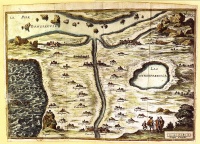Précieuses
From The Art and Popular Culture Encyclopedia
|
"The Hotel Rambouillet, the French Academy, and the "Précieuses," are acknowledged to have made French what it is; and in his history of polite society in France, Roederer plainly puts the "Précieuses" on a par with the Academy, and refers the origin of both to the famous Hôtel Rambouillet."--French Women of Letters (1862) by Julia Kavanagh "The late 17th and early 18th century is the great period of Camp: Pope, Congreve, Walpole, etc, but not Swift; les précieux in France; the rococo churches of Munich; Pergolesi."--"Notes on "Camp"" (1964) by Susan Sontag |
|
Related e |
|
Featured: |
The 17th-century French literary style and movement called préciosité, preciousness). The main features of this style are the refined language of aristocratic salons, periphrases, hyperbole, and puns on the theme of gallant love. The movement was similar to the Italian marinism, Spanish culteranismo, and English euphuism.
The movement arose in the 17th century from the lively conversations and playful word games of les précieuses , the intellectual, witty and educated women who frequented the salon of Catherine de Vivonne, marquise de Rambouillet. Her Chambre bleue (the "blue room" of her hôtel particulier) offered a Parisian refuge from the dangerous political factionalism and coarse manners of the royal court during the regency of Louis XIV.
One of the central figures of the salon that gathered at the Hôtel de Rambouillet was Madeleine de Scudéry. She wrote voluminous romance novels that embodied the refinements of preciosité including the concepts of feminine elegance, etiquette and courtly Platonic love that were hugely popular with female audiences, but scorned by most men, including Molière, who satirized the précieuses in his comedy Les Précieuses ridicules (1659). The "questions of love" that were debated in the précieuses' salons reflected the "courts of love" (fictional courts which judged lovers' behavior) that were a feature of medieval courtly love.
One préciosité parlor game, the retelling of fairy tales as if spontaneously (though the tales were in fact carefully prepared), was to have great effects. Many of these fairy tales, in the préciosité style, were written, mostly notably by Madame d'Aulnoy. This fashion for fairy tales, and the writers themselves, were a notable influence later upon Charles Perrault, and Gabrielle-Suzanne Barbot de Villeneuve, the author of Beauty and the Beast. The stories tended to vary from the folk tradition, for example the characters were made to be of genteel origin. Whilst the heroes and heroines of fairy tales written by the précieuses often appeared as shepherds and shepherdesses, in pastoral settings, these figures were often secretly royal or noble.
The précieuses are also remembered through the filter of Molière's one-act satire, Les Précieuses ridicules (1659). After years touring the provinces, this bitter comedy of manners brought Molière and his company to the attention of Parisians and attracted the patronage of Louis XIV. Les Précieuses ridicules is considered to be the origin of the pejorative connotation of précieuse as "affected".
The phenomenon of the précieuses in establishing French literary classicism was first revived by Louis Roederer in 1838. His Mémoires pour servir à l'histoire de la société polie en France, evoked an atmosphere of nostalgia for the douceur de vivre of the Ancien Régime and the aristocratic leisure of its authors, at least for the upper classes. Later, Roxane, a critical character in Edmond Rostand's 1897 play Cyrano de Bergerac, is described as a précieuse.
Significant authors
- Madame d'Aulnoy
- Jean-Louis Guez de Balzac
- Isaac de Benserade
- Charles Cotin
- Antoine Godeau
- Henriette-Julie de Murat
- Paul Pellisson
- Madeleine de Scudéry
- Honoré d'Urfé
- Vincent Voiture
See also


